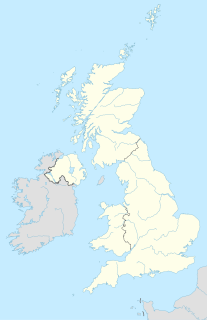
Scotland is a well-developed tourist destination, with tourism generally being responsible for sustaining 200,000 jobs mainly in the service sector, with tourist spending averaging at £4bn per year. In 2013, for example, UK visitors made 18.5 million visits to Scotland, staying 64.5 million nights and spending £3.7bn. In contrast, overseas residents made 1.58 million visits to Scotland, staying 15 million nights and spending £806m. In terms of overseas visitors, those from the United States made up 24% of visits to Scotland, with the United States being the largest source of overseas visitors, and Germany (9%), France (8%), Canada (7%) and Australia (6%), following behind.

Durbuy is a city and municipality of Wallonia located in the province of Luxembourg, Belgium.
A seaside resort is a town, village, or hotel that serves as a vacation resort and is located on a coast. Sometimes the concept includes an aspect of official accreditation based on the satisfaction of certain requirements, such as in the German Seebad. Where a beach is the primary focus for tourists, it may be called a beach resort.
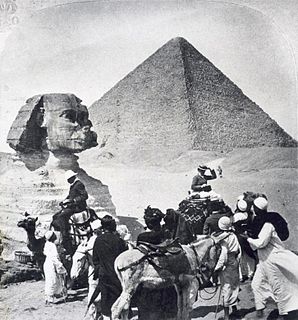
Cultural tourism is a type of tourism activity in which the visitor’s essential motivation is to learn, discover, experience and consume the tangible and intangible cultural attractions/products in a tourism destination. These attractions/products relate to a set of distinctive material, intellectual, spiritual and emotional features of a society that encompasses arts and architecture, historical and cultural heritage, culinary heritage, literature, music, creative industries and the living cultures with their lifestyles, value systems, beliefs and traditions.

The Cliffs of Moher are sea cliffs located at the southwestern edge of the Burren region in County Clare, Ireland. They run for about 14 kilometres. At their southern end, they rise 120 metres (390 ft) above the Atlantic Ocean at Hag's Head, and, 8 kilometres to the north, they reach their maximum height of 214 metres (702 ft) just north of O'Brien's Tower, a round stone tower near the midpoint of the cliffs, built in 1835 by Sir Cornelius O'Brien, then continue at lower heights. The closest settlements are the villages of Liscannor 6 km to the south, and Doolin 7 km to the north.

Digby is an incorporated town in southwestern Nova Scotia, Canada. It is in the historical county of Digby and a separate municipality from the Municipality of the District of Digby. The town is situated on the western shore of the Annapolis Basin near the entrance to the Digby Gut, which connects the basin to the Bay of Fundy.

Heritage interpretation refers to all the ways in which information is communicated to visitors to an educational, natural or recreational site, such as a museum, park or science centre. More specifically it is the communication of information about, or the explanation of, the nature, origin, and purpose of historical, natural, or cultural resources, objects, sites and phenomena using personal or non-personal methods. Some international authorities in museology prefer the term mediation for the same concept, following usage in other European languages.

Coral Bay is a small coastal settlement located 1,200 kilometres (750 mi) north of Perth, in the Shire of Carnarvon in the Gascoyne region of Western Australia.

Soomaa National Park is a national park in south-western Estonia. Soomaa protects 390 km², the park was created in 1993. Soomaa is Important Bird Area since 1989 and a Ramsar site of protected wetlands since 1997 and a Natura 2000 area since 2004.

Whiteshell Provincial Park is a 2,721 km2 park centrally located in Canada in the province of Manitoba. It is found in the southeast region of the province along the Manitoba-Ontario boundary, approximately 130 km east of the city of Winnipeg. The park is located in the Canadian Shield region and has many rivers, remote lakes, boreal forest and bare granite ridges. It has rare archeological sites of petroforms on flat granite ridges. The park is used year-round for nature-oriented recreation activities.
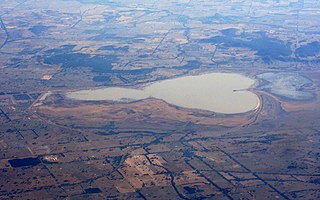
Lake Mokoan was an artificial lake in northern Victoria, Australia, roughly 7 km north-east of Benalla. It was created by diverting water from the Broken River and Hollands Creek into Winton and Green swamps. Construction began in the late 1960s and was completed in 1971.
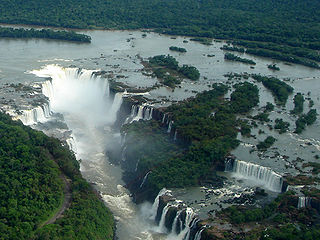
Geotourism is tourism associated with geological attractions and destinations. Geotourism deals with the abiotic natural and built environments. Geotourism was first defined in England by Thomas Alfred Hose in 1995.
The European Travel Commission (ETC) is an association of National Tourism Organisations (NTOs) based in Brussels. It was created in 1948 to promote Europe as a tourist destination to long-haul markets outside of Europe, originally the US and later Canada, Latin America and Asia-Pacific. ETC currently has 33 member NTOs and 14 associate members from the private industry. The association aims to raise awareness of the importance of tourism among national European authorities and the general public through sharing best practices and cooperation in market intelligence and promotion.
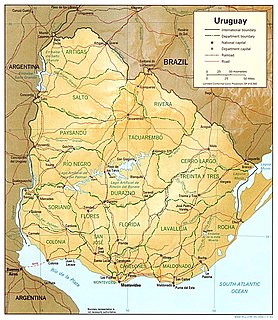
Tourism in Uruguay is one of the most important facets of the nation's economy.

Tumbulgum is a village in northern New South Wales, Australia. It is in the Tweed Shire local government area, at the confluence of the Rous and Tweed Rivers, 818 kilometres (508 mi) north east of the state capital, Sydney and 120 kilometres (75 mi) south east of Brisbane. At the 2006 census, Tumbulgum had a population of 349.

European Destinations of ExcelleNce, also known by the acronym EDEN, is an initiative launched by the European Commission promoting sustainable tourism development models across Europe. The project is based on national competitions which take place every year since 2006 and results in the selection of a “destination of excellence” for each participating country. The winners are emerging, lesser known destinations located in the 27 EU Member States, the Candidate Countries and the EFTA/EEA countries.
Fashion tourism is a niche market segment evolved out of three major sectors: Creative Tourism, Cultural Tourism and Shopping Tourism. Fashion Tourism can be defined as “the interaction between Destination Marketing Organizations (DMOs), trade associations, tourism suppliers and host communities, with people travelling to and visiting a particular place for business or leisure to enjoy, experiment, discover, study, trade, communicate about and consume fashion.”

The Fishing Museum is a museum opened in 2002 and dedicated to the knowledge and dissemination of fishing and the maritime heritage of the Costa Brava. It's located in the area of the fishing port of Palamós, in the old port warehouse called "Tinglado". The permanent exhibition explains the history, the current affairs and the future of Costa Brava fishing in terms of sustainability.

Saskatchewan Landing Provincial Park is a provincial park in Saskatchewan, Canada. It is located in the valley of the South Saskatchewan River and the west end of Lake Diefenbaker, about 50 km (31 mi) north of Swift Current, Saskatchewan. The park is 5,735 hectares in size.
The Dolphin Nature Conservation Society (DNCS) is a registered voluntary environmental non-profit and non-governmental organization (NGO) located in Visakhapatnam, Andhra Pradesh, India. It is committed to the causes of nature conservation, environmental protection, research, education, and awareness. The society was founded on March 5, 2001, by Dr. Mantha Rama Murty and Dr. Mangathayi, who had previously launched several nature conservation programs in Andhra Pradesh, particularly in Visakhapatnam. The organization's activities are intended to instill a love for nature and conservation among people, especially among the younger generation. Notable research, documentation, conservation and awareness campaigns of the society have involved Olive-Ridley Sea Turtles, intertidal rocky shore fauna and flora of the Visakhapatnam coast and butterflies of the Eastern Ghats. The society's flagship project is the development and maintenance of the Biodiversity Park in Visakhapatnam.

















